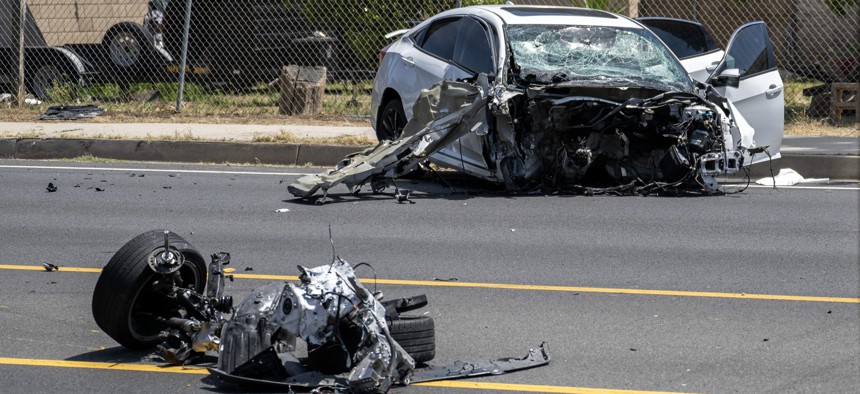Traffic deaths decline slightly, but remain higher than before the pandemic

An 8-year-old boy was killed and four others were injured after a head-on collision in May 2023 in Riverside, California. Gina Ferazzi / Los Angeles Times via Getty Images
Safety experts have struggled to pinpoint why traffic and pedestrian fatalities have remained so stubbornly high.
America’s traffic safety crisis stretched through a fourth year in 2023, with only modest signs of slowing, according to newly released data.
Road deaths decreased by 4% last year, compared to 2022, according to preliminary data from the National Safety Council. If the numbers hold, it would be the third year in a row that traffic fatalities declined. But the total of 44,450 lives lost would still be higher than in 2020—when skyrocketing traffic deaths during COVID-19 lockdowns alarmed safety experts—or any pre-pandemic year since 2006.
“The most dangerous thing most people in our country do in a single day is use the U.S. roadway system. This public health crisis is an atrocity that must continue to be addressed,” said Mark Chung, executive vice president of roadway practice at the National Safety Council, in a statement.
Most states saw decreases in traffic fatalities in 2023, including a dozen with drops of 10% or more. Alaska saw a 31% drop, the biggest rate of decrease among states. That amounted to 25 fewer deaths in 2023 than in 2022. But California had the biggest improvement in overall numbers, with 321 fewer people killed on the roads last year than the year before.
Meanwhile, fatalities increased by 42% in Washington, D.C., and 35% in Rhode Island—the biggest percentage upticks in the country. In Arizona, 292 more people died in traffic in 2023 than the year before, the highest increase of any state.
The news on overall fatalities echoes findings from a separate report on pedestrian safety in 2023 that the Governors Highway Safety Association also released this week. GHSA found that the number of pedestrians killed on U.S. roads dropped by 4% in the first half of 2023, but still remain 14% higher than they were before the pandemic.
If the trend continues through the end of 2023, last year would mark the first time since 2010 that pedestrian deaths decreased. (GHSA will update its estimates for all of 2023 later this year.)
“After witnessing pedestrian deaths rise each year, it’s encouraging to finally see a small decrease,” said Jonathan Adkins, GHSA’s CEO, in a statement. “But the fact remains that 18 people go for a walk every day and don’t return home due to preventable crashes. The only acceptable number of traffic deaths is zero.”
Pedestrian deaths declined in 29 states and D.C. in early 2023, according to GHSA, but 18 states saw increases.
California, Florida and Texas are especially worrisome, GHSA said, because they account for 37% of all pedestrian deaths in early 2023 but are only home to 27% of the U.S. population. “These states have warmer climates, which tend to increase travel on foot, as well as many urban areas where pedestrians and motor vehicles are more likely to share the road,” the group wrote.
Safety experts have struggled to pinpoint why traffic deaths have remained so stubbornly high since the onset of the pandemic.
Initially, many blamed reckless driving by motorists while streets were comparatively empty during lockdowns. But the elevated numbers continued even when traffic returned. Last year marked the first year that Americans drove more than they did prior to the pandemic, even as commuting patterns have shifted away from traditional times and routes.
Another factor seems to be an increase in distracted driving. Americans picked up bad habits of multitasking while driving during the pandemic and never stopped, according to Cambridge Mobile Telematics, which monitors driver behavior for insurance companies.
But vehicles have been changing too, as more people drive heavy and more powerful SUVs and pick-up trucks compared to passenger cars. The boxy shapes of many new models have created bigger front-end blind spots for many drivers, and the higher hoods are more deadly for pedestrians.
“A steep drop in traffic enforcement across the country since 2020 has enabled dangerous driving behaviors—including speeding and driving impaired— to flourish,” argued GHSA.
“At the same time, roads are largely designed to prioritize fast-moving vehicle traffic instead of slower speeds that are safer for people walking,” the group added. “Many parts of the country lack infrastructure—such as sidewalks, crosswalks and lighting—that help protect people on foot. The U.S. vehicle fleet is increasingly dominated by larger, heavier vehicles that are more likely to injure or kill people walking.”
Biden administration officials have highlighted the high number of traffic deaths for two years, calling for a “safe systems” approach that would create redundant systems to protect motorists, cyclists and pedestrians. But those have had limited success, with many state and local officials resisting street designs that would limit vehicle speeds, automakers doubling down on larger vehicles and the public remaining largely ambivalent about the crisis.






